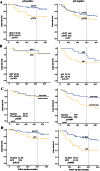Targeted Therapy in Oropharyngeal Squamous Cell Carcinoma: The Implications of HPV for Therapy
- PMID: 27182480
- PMCID: PMC4837939
- DOI: 10.1007/s40487-015-0008-5
Targeted Therapy in Oropharyngeal Squamous Cell Carcinoma: The Implications of HPV for Therapy
Abstract
Oropharyngeal cancers caused by human papillomaviruses (HPV) have a different epidemiology, prognosis, genetic mutational landscape, response to treatment, and outcome when compared to HPV-negative cancers. In this review, a summary of our current understanding of HPV in head and neck cancer and the important advances that have shown HPV to be an etiological agent are discussed. HPV-positive and HPV-negative tumors are compared discussing clinicopathological factors, prognosis, outcome following treatment, and the molecular and genetic differences. Currently, the standard of care for oropharyngeal cancer is both surgery and post-operative radiotherapy with or without cisplatin or concurrent chemo-radiotherapy. The latter is used more often, especially in cancers of tonsil and base of tongue. However, there is increased interest in trying to de-intensify treatment and in the development of new treatments to target the underlying different molecular pathways of HPV-positive cancers. The current clinical trials involving surgery, chemotherapy, and radiation therapy are discussed. The new targeted treatments are also summarized. Although there is currently is no evidence from prospective studies to support a change in the treatment algorithm, the treatment options for patients with HPV-positive disease are likely to change in the future.
Keywords: Human papillomavirus; Oropharyngeal; Radiotherapy; Robotic surgery; Squamous cell carcinoma; Targeted therapy.
Figures






Similar articles
-
Radiation therapy dose de-escalation compared to standard dose radiation therapy in definitive treatment of HPV-positive oropharyngeal squamous cell carcinoma.Radiother Oncol. 2019 May;134:81-88. doi: 10.1016/j.radonc.2019.01.016. Epub 2019 Feb 4. Radiother Oncol. 2019. PMID: 31005228
-
The rationale for HPV-related oropharyngeal cancer de-escalation treatment strategies.Contemp Oncol (Pozn). 2015;19(4):313-22. doi: 10.5114/wo.2015.54389. Epub 2015 Sep 28. Contemp Oncol (Pozn). 2015. PMID: 26557780 Free PMC article.
-
The prognostic value of extranodal extension in human papillomavirus-associated oropharyngeal squamous cell carcinoma.Cancer. 2017 Jul 15;123(14):2762-2772. doi: 10.1002/cncr.30598. Epub 2017 Mar 21. Cancer. 2017. PMID: 28323338
-
Future treatment directions for HPV-associated head and neck cancer based on radiobiological rationale and current clinical evidence.Crit Rev Oncol Hematol. 2016 Jul;103:27-36. doi: 10.1016/j.critrevonc.2016.05.002. Epub 2016 May 11. Crit Rev Oncol Hematol. 2016. PMID: 27221393 Review.
-
Human papillomavirus in oropharyngeal cancer: The changing face of a disease.Biochim Biophys Acta. 2016 Dec;1866(2):141-150. doi: 10.1016/j.bbcan.2016.07.005. Epub 2016 Jul 31. Biochim Biophys Acta. 2016. PMID: 27487173 Review.
Cited by
-
Molecular detection of human papillomavirus-16 among Sudanese patients diagnosed with squamous cell carcinoma and salivary gland carcinoma.BMC Res Notes. 2021 Feb 9;14(1):56. doi: 10.1186/s13104-021-05471-5. BMC Res Notes. 2021. PMID: 33563329 Free PMC article.
-
A novel human in vitro papillomavirus type 16 positive tonsil cancer cell line with high sensitivity to radiation and cisplatin.BMC Cancer. 2019 Mar 25;19(1):265. doi: 10.1186/s12885-019-5469-8. BMC Cancer. 2019. PMID: 30909875 Free PMC article.
-
Mutation-associated transcripts reconstruct the prognostic features of oral tongue squamous cell carcinoma.Int J Oral Sci. 2023 Jan 3;15(1):1. doi: 10.1038/s41368-022-00210-3. Int J Oral Sci. 2023. PMID: 36593250 Free PMC article.
-
Collagen Induces a More Proliferative, Migratory and Chemoresistant Phenotype in Head and Neck Cancer via DDR1.Cancers (Basel). 2019 Nov 9;11(11):1766. doi: 10.3390/cancers11111766. Cancers (Basel). 2019. PMID: 31717573 Free PMC article.
-
Longitudinal characterization of the tumoral microbiome during radiotherapy in HPV-associated oropharynx cancer.Clin Transl Radiat Oncol. 2020 Nov 18;26:98-103. doi: 10.1016/j.ctro.2020.11.007. eCollection 2021 Jan. Clin Transl Radiat Oncol. 2020. PMID: 33367119 Free PMC article.
References
Publication types
LinkOut - more resources
Full Text Sources
Other Literature Sources
